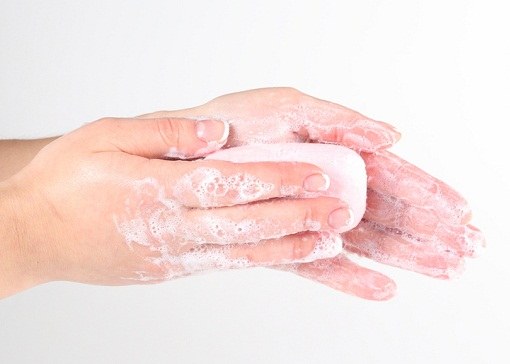Tip 1: How to wash the mounting foam off your hands
Instruction
Remember: if mounting foam gets on the skin, you need to act very quickly, otherwise the foam will harden and then you will have to wait a few days until it falls off by itself along with dead epithelial cells. Try to gently remove the foam from your hands with a rag. Be very careful not to smear the foam on your skin! Next, try to remove the foam from the skin with gasoline, acetone, or cleaner. Even ordinary nail polish remover will do. Be extremely careful when using products such as cleaner or gasoline, follow the safety rules!
If neither gasoline, nor acetone, nor a cleaner helped, or they simply are not in your home, try another method. Pour warm water into a basin and add table salt. Dip your hands in the water and wait for a while. To enhance the effect, try to wipe the mounting foam off the skin with a hard washcloth or pumice stone. Soapy water also helps to get rid of mounting foam. Hold your hands in such water, from time to time carefully lathering them and rubbing the foam from the skin with a sponge or washcloth. You should not immediately proceed to the next step if the foam is not washed off within 5-10 minutes, since washing the foam from your hands with soap and warm water is a rather lengthy process.
There is another way that installers sometimes use. Take vegetable oil, warm it up and lubricate the skin of your hands with it. Then put a little washing powder on your hands, gently and thoroughly wipe the foam from your hands with it. You can also use a pumice stone or a hard washcloth. Rub until the foam is removed from your hands, then rinse your hands thoroughly with warm water. You can just properly lubricate your hands with sunflower oil and wait 10-20 minutes, and then wash off the oil with water. Most likely, the mounting foam will wash off along with the oil.
When installing doors, both entrance and interior, when replacing windows, you may encounter the problem of cleaning surfaces from mounting foam. Foam can get on the painted frame or door jamb, fall on the flooring. Before using any foam remover, test it on an inconspicuous area or a separate piece of material.
You will need
- Removing fresh mounting foam
- - special liquid for washing construction pistols
- - nail polish remover
- - vinegar
- - rags
- - cotton pads
- Removing dried foam
- - a special agent for removing hardened foam
- - brush
- - putty knife
- - rags
- - drug "Dimexide"
- - hard side kitchen sponge
- - knife
- - Toothbrush
Instruction
Removal of fresh mounting foam.
Uncured assembly foam remove from surfaces with a special liquid for washing guns. Test the effect of this agent on the material in an inconspicuous place. If the surface has remained resistant to aggressive environments, the top layer has not been damaged, the paint has not peeled off, then moisten a rag with the product and wipe off the fresh mounting foam.
Remove small drops of fresh mounting foam with nail polish remover. Moisten a cotton pad with liquid and wipe the stained area.
Removal of dried mounting foam.
To dissolve dry mounting foam, buy a special tool at a hardware store. The product packaging should contain instructions for use. Usually such products are sold in the form of a paste or gel, which are applied to the surface with a brush, and then removed with a spatula along with softened foam. Remember to test the product on an inconspicuous area of the surface.
Cut off a thick layer of foam with a knife, then carefully peel off a small piece of foam so as not to damage the surface of the material. Take a dry kitchen sponge. With its hard side, slowly wipe off the remnants of the dried foam. Take your time to avoid leaving scratches behind.
Buy the drug "Dimexide" at the pharmacy. Moisten them with a rag. Lay the cloth over the foamed area for a couple of minutes, being careful not to corrode the nearby surface. softened foam scrape off with the blunt side of a knife or an old toothbrush. The product cleans both old and fresh foam.
note
If the foam gets on your hands, then use special tools with extreme caution. Without the use of funds, after a few days, the foam from the hands will come off by itself from exposure to sebum.
Sources:
- http://www.woodworkshop.ru/index.php/forum/15-razgovori/17-kak_udalit_montazjnui_penu.html
- how to clear foam
Polyurethane foam is widely used in everyday life and construction. It is a viscous mass that hardens in air. In case of inaccurate use, the foam may get on the skin. Do not delay the cleansing process - over time it will be difficult to remove.

You will need
- - Special cleaner;
- - cleaning wipes;
- - cleaning powder;
- - detergent;
- - vegetable oil;
- - nutritious cream.
Instruction
Removing the mounting foam is not difficult if it has not yet hardened. Get a special solvent from the hardware store - it is usually available in the form of an aerosol. Also on the counter you can find napkins-cleaners. Study the composition carefully. Some products are too aggressive, so they are not recommended for cleansing the skin. Wipe off as much foam as possible with a rag. Then soak a cotton pad in the product and wipe your hands thoroughly. Try not to miss any contaminated area. A special solvent can be replaced with acetone, gasoline or nail polish remover.
Hardened polyurethane foam can only be removed mechanically, or you will have to wait a few days for it to fall off by itself. Heat vegetable or any other oil. Check the temperature with the back of your wrist - it should be bearable so as not to burn yourself. Then lubricate your hands evenly. Apply a little cleaning or washing powder and rub the skin vigorously. You can use a stiff brush, the back of a foam sponge, or a pumice stone.
Pour hot water into the container and add any detergent. Stir and dip your hands in the soapy solution. Leave on for 15-20 minutes. Then lather your hands and scrub your skin vigorously with a washcloth. Repeat the procedure until the complete removal of the mounting foam.
After the hands are completely cleansed, apply any nourishing cream or regular vegetable oil. Remember that polyurethane foam products negatively affect the condition of the skin. Irritation or an allergic reaction may occur.
Helpful advice
Always wear rubber gloves during construction work. Instead, you can apply a hydrophilic cream on your hands. It contains special substances that cover the skin with a protective film.
Sources:
- how to clean hands from polyurethane foam
Polyurethane foam has become a popular material in construction, it has excellent adhesive properties. But if the foam gets on the clothes, washing it is not so easy. There are several ways to return clothes to their original appearance.

You will need
- - aerosol cleaner;
- - napkins or sponge;
- - brush;
- - a sharp knife;
- - nail polish remover;
- - white spirit, gasoline or acetone;
- - needle;
- - nail scissors.
Instruction
There is a special aerosol cleaner for both fresh and hardened foam. If foam gets on your clothes, you can easily remove it. Apply the cleaner on the stain, soak for a few minutes (read the time of the cleaner on the bottle). Then collect the remaining foam with napkins or a clean sponge. If particles of foam remain on the fabric, then perform this procedure again. When removing a stain, try to wash it off carefully so as not to damage the fabric.
